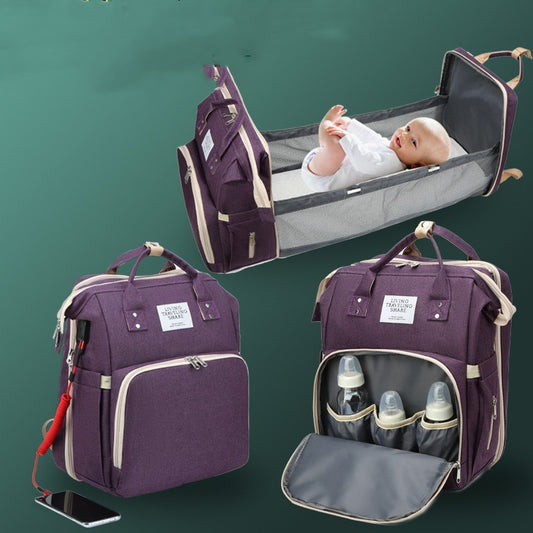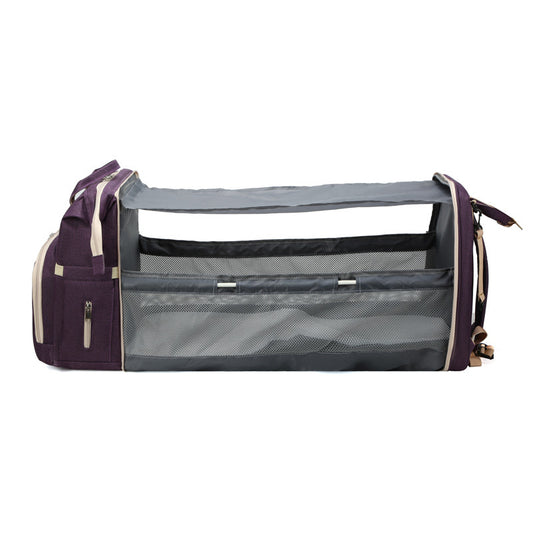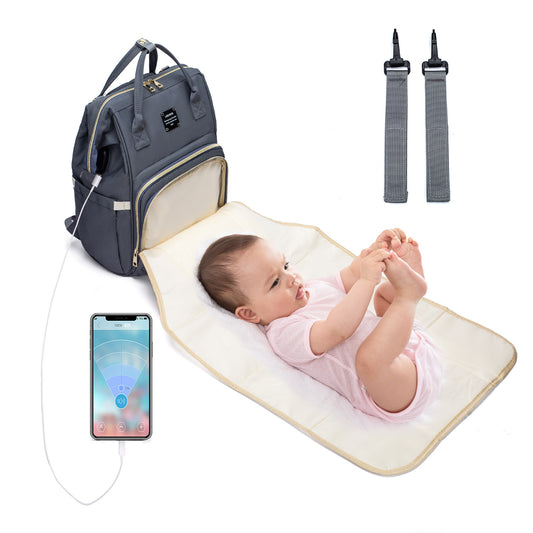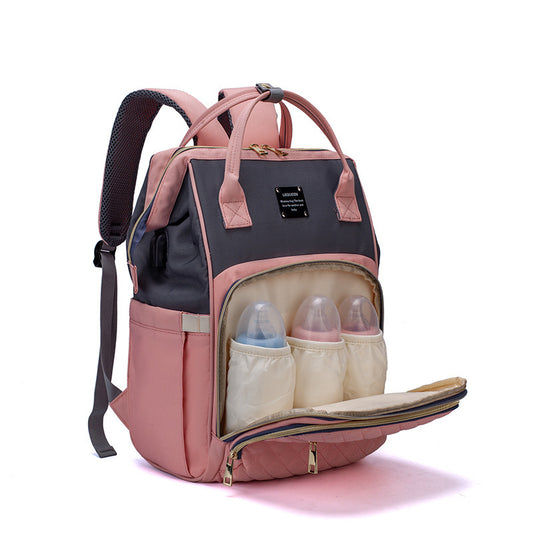Today’s parents are not just focused on practicality and design — they’re also increasingly mindful of the impact their choices have on the planet. As eco-awareness grows in the UK, more mums and dads are looking beyond traditional baby gear and turning to eco-friendly baby changing bags that support a cleaner, more sustainable future.
But what does “eco-friendly” really mean when it comes to nappy bags? Are these sustainable options truly functional, or is it just another trend?
In this guide, we dive into:
-
What makes a changing bag eco-friendly
-
Which materials are safe and sustainable
-
How to identify a sustainable product beyond the label
-
Practical, long-term reusable bag options
-
Review of options available at Kidyra.Store
Why Choose an Eco-Friendly Baby Changing Bag?
Your baby changing bag is one of the most frequently used items in your parenting kit. Choosing a bag made from responsible materials and designed to last is one of the easiest ways to reduce waste and embrace a more conscious lifestyle.
Three Key Reasons to Choose Sustainable baby bags:
1. Reduced Environmental Impact:
Conventional bags often use PVC, petroleum-based dyes, and non-recyclable plastics. Eco-friendly alternatives avoid toxins and use materials designed to reduce microplastic shedding and landfill build-up.
2. Safety for Baby:
Natural or non-toxic materials mean baby products, feeding items, clothes, and nappies are less likely to come into contact with pollutants or harmful chemicals (like phthalates, lead, or PVC).
3. Durability and Value:
A sustainably crafted changing bag is designed for long-term use, often lasting well past the baby stage — easily converted to a travel, gym, or work bag.
What Makes a Baby Changing Bag Eco-Friendly?
A truly eco-conscious baby changing bag is more than just a label. Look for the following features:
1. Sustainable Materials
Preferred materials include:
-
Recycled PET fabric (rPET): Made from recycled plastic bottles. Strong, durable, and reduces ocean waste.
-
Organic cotton canvas: Grown without pesticides and processed minimally. Breathable and biodegradable.
-
Vegan or plant-based leather: Animal-free and free from harmful tanning chemicals.
-
Water-based coatings: Avoid synthetic or petroleum-based waterproofing (e.g., PVC or PU).
Kidyra’s changing bags, like those available on your featured pages, are made from waterproof Oxford fabric, which is durable, lightweight, and long-lasting, reducing product turnover and plastic waste.
2. Non-Toxic and Baby-Safe Finishes
Ensure the bag avoids:
-
PVC
-
BPA
-
Lead
-
Formaldehyde
-
Phthalates
These are common in cheap baby bags and can off-gas or leach into fabrics and wipe containers.
3. Multipurpose Design for Long-Term Use
A bag should evolve with your life. Look for features that allow repurposing as a:
-
Weekender bag
-
Work bag (with laptop sleeve)
-
Travel backpack
-
Gym gear organiser
The Kidyra bags listed in the screenshots include insulated compartments, USB ports, and over 12 organisational sections, making them fit for much more than just baby gear.
4. Repairability and Durability
A strong eco product should be:
-
Resistant to tears and scratches
-
Easy to wipe clean
-
Well-stitched with reinforced zips
-
Designed to avoid early failure
If a product’s design causes tears, peeling, split straps, or weak zips within a year, that’s not eco — even if the fabric is labelled recyclable.
Comparing Kidyra Bags to Eco-Friendly Standards
While the Kidyra bags aren't explicitly labelled "eco-friendly" from a material certification standpoint (e.g., GOTS or OEKO-TEX), their multi-functional design, durability, and long-term usability align with key sustainability principles in 2025:
|
Feature |
Eco Impact |
|
Oxford fabric construction |
Durable, water-resistant, long-lasting |
|
Insulated bottle storage |
Reduces single-use packaging/tools |
|
Removable changing mat |
Reusable, reduces dependence on disposable pads |
|
Compartments for all hygiene needs |
Reduces need for carrying multiple bags |
|
Gender-neutral styles |
Reusable by future children/siblings |
|
Multi-use features (USB, laptop compartment) |
Great for work-life reuse |
The modular layout, waterproof lining, and options for stroller clips or cot conversion (in some models) also make them significantly more sustainable per use compared to single-purpose, style-focused bags.
The Problem with Fast Baby Gear
Many baby gear brands focus on trends over function. Bags are often:
-
Poorly made
-
Sourced from questionable supply chains
-
Lined with low-grade plastic
-
Discarded within a year
This creates unnecessary waste, especially for an item that could otherwise be reused for years.
Investing in a durable, multi-use, and repairable bag helps reduce your environmental footprint — and your total baby gear budget.
Our Top Picks: Sustainable Baby Changing Bags from Kidyra.Store
1. Large Diaper Bag Backpack with Insulated Pockets & Changing Mat
Material: Oxford waterproof fabric
Usage: Diaper, travel, work, and pram organiser
Eco Points: Multi-purpose use; reusable changing mat; stroller straps reduce need for separate caddy
Best For: Parents who walk daily, use public transport, or need an all-in-one bag
Colours Available: Red, grey, purple, navy, green
2. Large Nappy Backpack with Insulated Pockets & USB Port
Material: Durable Oxford fabric
Usage: Smart organisation for bottles and work gear
Eco Points: Offers extended usability beyond parenting years; no short-term throwaway design
Best For: Commuters, dads, and mums who prefer neutral bags they can also take to work
Colours Available: Pink, grey, navy, green, dark blue, black
Both are priced affordably compared to designer bags and avoid branded luxury markups that do little for sustainability.
How to Tell if a Baby Bag Is Truly Eco-Friendly (Buyer’s Checklist)
Before buying, ask yourself the following:
-
Is the main fabric durable, water-resistant, and repairable?
-
Are the pockets washable and reusable?
-
Can the bag be used beyond the baby stage?
-
Is it free from PVC, BPA, phthalates, or harsh dyes?
-
Does the product claim short-term use, or support repurposing?
If most boxes are ticked, you're making a better long-term and environmental decision.
Sustainable Care Tips for Longer Life
Even the most eco-conscious product only stays eco if it's well cared for.
Simple tips:
-
Clean regularly with warm water and cloth-safe detergent (avoid harsh chemicals)
-
Always air-dry—tumble drying degrades outer coatings
-
Store in a breathable area, not plastic boxes where bacteria can grow
-
Use internal organisers to avoid spills into the base lining
-
Repair if needed, rather than replace when minor damage occurs
Refer to our [How to Clean Your Baby Changing Bag Blog] for full maintenance steps.
Conclusion
As modern parenting moves towards more conscious practices, choosing an eco-friendly baby changing bag is a smart, forward-thinking decision. Whether you’re shopping for your first bag or replacing a previous one, the goal should always be sustainability by design, not just by label.
Look for materials that last, compartments that support organisation, and bags that evolve with your needs — from bottles and bibs to laptop and lunch.
The good news? Sustainable baby bags don’t require luxury budgets or sacrifices. Brands like Kidyra.Store offer responsible, long-use products with all the versatility and comfort modern parents need.
Your parenting bag can go beyond nappies — and beyond landfill.
Browse our selection of durable, functional, and eco-conscious baby changing bags at Kidyra.Store today.
FAQs
Q1. Are eco-friendly baby changing bags expensive?
Not necessarily. Many sustainable-focused designs are comparable in price to premium nappy bags, especially if built for multi-use and durability.
Q2. Can I find eco features in bags under £60?
Yes. Bags made with high-grade Oxford fabric or recycled PET often fall within this range and still offer outstanding longevity.
Q3. Are Oxford fabric bags sustainable?
While not 100% organic, Oxford fabric is long-lasting, water-resistant, and supports long-term use, making it a strong sustainable choice by durability.
Q4. What should I avoid in a baby bag if I want an eco-friendly option?
Avoid PVC vinyl lining, single-use disposable changing mats, and bags that peel, rip, or sag after short-term use.
Q5. Can eco baby bags be machine washed?
Check the label. Most should only be wiped clean and air-dried to preserve the waterproof coating.





